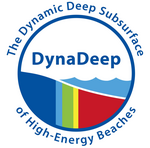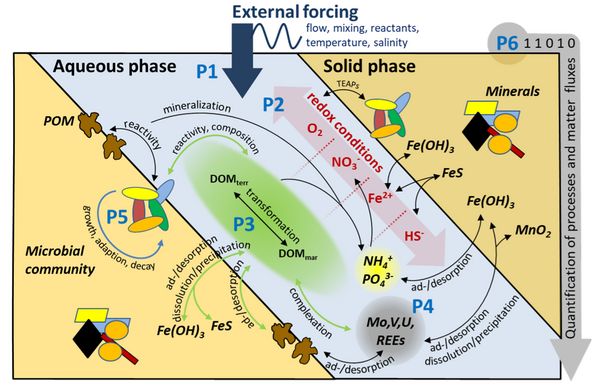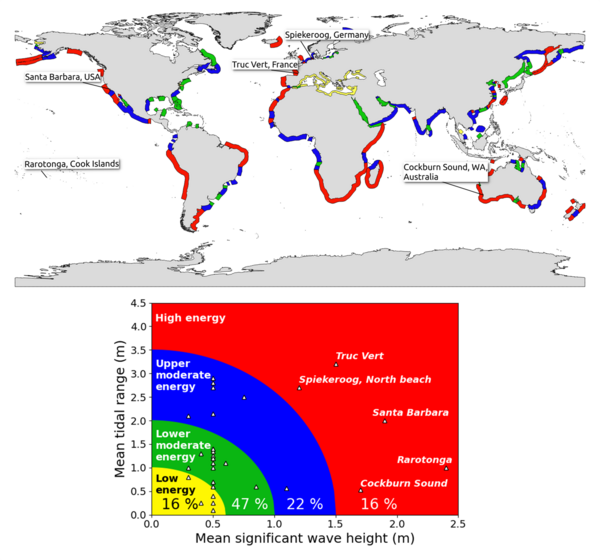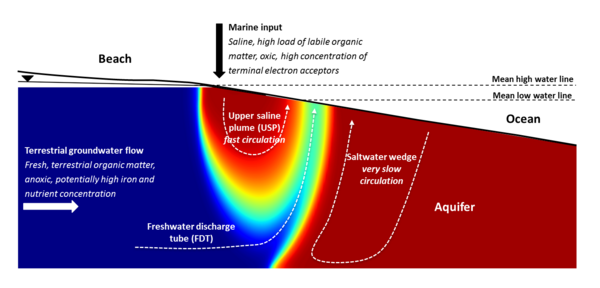
News
- Next regular meeting: 12/12/2025
- Next field campaign: 24/11/2025 to 05/12/2025
Spokesperson
Prof. Dr. Gudrun Massmann
Carl von Ossietzky University of Oldenburg
Contact
Infrastructure: Kai Schwalfenberg
Carl von Ossietzky Universität Oldenburg
Scientific coordination: Dr. Nele Grünenbaum
Carl von Ossietzky Universität Oldenburg
Funding and duration
Funding: German Research Foundation (DFG)
Phase 1: 2021 - 2025
Phase 2: 2025 - 2029
DynaDeep

The Dynamic Deep Subsurface of High-Energy Beaches
The research unit DynaDeep aims to gain a deeper understanding of the physical and biogeochemical processes in the subsurface of high-energy beaches, the so-called subterranean estuary. Detailed understanding of these processes is a prerequisite for a better prediction of nutrient fluxes in the transition zone between land and sea and their effects on coastal ecosystems.
We propose the existence of a so far unexplored biogeochemical reactor within the deep subsurface of high-energy beaches, where dynamic boundary conditions propagate tens of meters into the subsurface, leading to strong spatio-temporal variability of geochemical conditions. Subterranean estuaries below high-energy beaches may thus form a unique habitat with an adapted microbial community unlike other typically more stable subsurface environments.
DynaDeep will study flow and transport patterns as a function of hydro- and morphodynamics. It will deliver transformation rates of organic matter and investigate related redox processes in the biogeochemical reactor. Furthermore, DynaDeep will assess transformation and fractionation of trace metals and metal isotopes and study the diversity and metabolic functioning of microbial communities. Ultimately, DynaDeep will elucidate the global relevance of this biogeochemical reactor for coastal ecosystems.
The subterranean estuary
The subsurface of a beach is called subterranean estuary (STE) and connects inland groundwater bodies with the sea. Subterranean estuaries deliver solutes such as carbon, nitrogen and trace elements to the ocean and affect the ecosystem of coastal waters.
STEs are considered powerful biogeochemical reactors fueled by terrestical and marine inputs. Mixing and residence time on the underground flow paths control the extent to which reactants are delivered, transformed and ultimately discharged into the ocean. These processes in turn depend on parameters such as groundwater inflow, tides, waves and beach surface morphology.
The established classical concept of groundwater flow and transport in a tidally influenced STE (see Figure below) describes a tide-induced saline recirculation cell (“upper saline plume”) overlying a so-called freshwater discharge “tube”, which again overlies a density- driven saltwater wedge. Due to dispersive mixing with recirculated seawater (red color) along the flow path, the freshwater (blue color) generally becomes brackish before it discharges near the low tide mark.
Flow and transport below high-energy beaches
High-energy beaches are characterized by strong morphodynamics due to intensified tide and wave conditions as well as storm events. We hypothesize that these dynamic hydrological and geomorphological boundary conditions propagate deep into the subsurface of high-energy beaches, leading to extremely transient and complex porewater flow and transport patterns down to tens of meters of depth.
The movie below shows the simulation result of a dynamic density-dependent groundwater flow model that was used to explore this phenomena (Greskowiak and Massmann 2021). The model incorporated storm floods and the effect of morphodynamics on groundwater flow.
The biogeochemical reactor
Within the STE biogeochemical reactor a large number of hydrobiogeochemical reactions occur. Fueled by terrestrial and marine organic matter, microbial communities control redox reactions that change organic matter composition, nutrient concentrations and pH. These changes in turn trigger mineral and surface reactions, thereby modifying the water composition on its way through the STE (see conceptual Figure below).
The biogeochemical processes are controlled by both matter input and flow and mixing processes in the pores. Therefore we hypothesize that the dynamic boundary conditions have a major impact on the reactive capacity of the biogeochemical reactor.

Global relevance
Many global beaches display high-energy conditions, being exposed to high waves and tidal range (see red areas in Figure below). Likely due to the difficult conditions during field work, their subsurface is currently understudied. The figure shows that only 16% of all STE studies reported on (minimum sampling depth 0.5 m) were carried out in a high-energy environment (see labelled sites on the map). At most of these sites, biogeochemical data was not acquired at greater depth and microbial communities were not considered. Thus, although very common and therefore presumably important in modifying solute fluxes to coastal waters, the bioreactor below high-energy beaches has so far remained largely unexplored.



